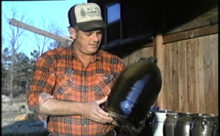The Market for Jerry Brown Pottery
When Jerry and Sandra Brown first opened their shop in the early 1980s, they were uncertain about their venture. The Brown’s distress about the declining traditional market for stoneware was eased by the discovery of a demand for Alabama folk arts and crafts. They found that they could attract customers as diverse as hardware stores and art museum gift shops. At first, the Brown’s wares were priced at two dollars a gallon. (Pricing by the gallon was the established practice for earlier folk potters. Numbers inscribed on the sides of old pottery refer to the number of gallons a vessel will hold.) But soon Jerry realized that this method of pricing no longer worked. They adjusted their prices are so reasonable that many customers can afford to buy their pottery through the mail from as far away as California and the northern states. Local customers still use Brown pottery as it was intended— to put up kraut, make home brew, serve food or pour tea. Urban and out-of-region customers tend to buy forms such as face jugs and churns for their decorative and artistic qualities.
It is interesting to consider the evolution of the significance of the face jugs (a jug form sculpted to resemble a human face) as part of the southern potter’s repertoire and as a measure of the shift in the potter’s market. Because these figural pottery vessels are found in both Europe and West Africa, scholars disagree about their origins. The face jug has been a traditional, though non-utilitarian, part of the Brown repertoire since the 19th century but Jerry Brown makes many more face jugs than his ancestors did. They were a rare item in the past because they were time-consuming to make and were not usable— they did not earn money for the potter. Therefore, old face jugs are much prized by antique collectors. Jerry Brown’s face jugs are much prized by antique collectors. Jerry Brown’s face jugs will not be scarce items in the future. Because of their decorative and humorously grotesque character— and perhaps because of their relationship to the valuable antique "collectibles"— the Browns can sell as many face jugs as they make.
Nowadays those interested in buying stoneware produced by the Jerry Brown Pottery can go about it a number of ways. Customers can drive to the site of his pottery in northwest Alabama, using the billboards erected along the roadside to guide them along. Many are exposed to the Browns’ pottery through arts and crafts fairs where Jerry demonstrates turning on the wheel. Some customers continue to buy pottery from the Browns, often ordering by mail with the aid of a printed price list. Others buy the ware indirectly, at hardware stores or gift shops.
From 1985 through 1987, Jerry Brown participated in the Folk Arts Apprenticeship Program of the Alabama State Council on the Arts. The Apprenticeship Program, which is supported by grants from the Folk Arts Program of the National Endowment for the Arts, encourages the transmission of folk art skills from accomplished master folk artists to their students. In his case, Jerry worked primarily with his stepson Jeff Wilburn who is now a full-time potter at the Brown Pottery.
Today business is thriving and the family is committed to their work, so the chances are good that Brown’s Pottery of Hamilton, Alabama will persist for another generation if not more. All this is due to the face that Jerry Brown decided to fulfill what he, his family, and many others have learned to appreciate as a very meaningful legacy.
